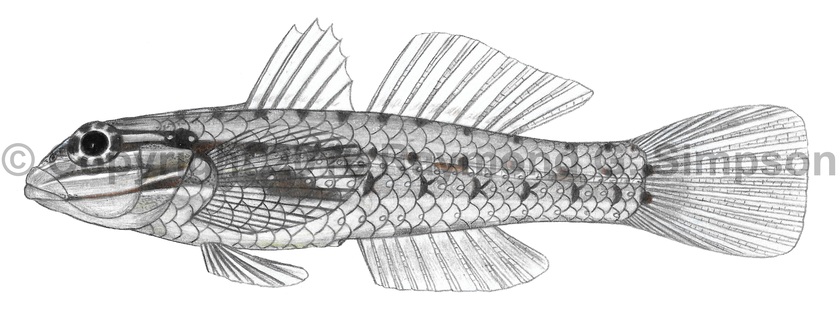
Common Name
Sand Goby
Year Described
Jordan, 1904
Identification
Dorsal Fin: VI; I, 9
Anal Fin: I, 9
Pectoral Fin: 18-20 (usually 19)
Pelvic Fin: I, 5
Caudal Fin: 17 segmented rays
Lateral Line Scales: 26-27
Vertebrae: 9+17=26
Body elongate. Snout profile straight. Eyes large and placed dorsally. A fleshy ridge present on nape from between eyes to dorsal fin origin. Anterior nostril tubular. Posterior nostril not tubular. Mouth small. Tongue truncated. No teeth on vomer or palatine. Teeth in jaws present in several irregular rows. Gill membranes joined to isthmus. Pectoral, soft dorsal, and anal fins with all rays branched and bound by membranes (first element simple). Second dorsal base longer than caudal peduncle length. Ventral fins fused into complete disk with front membrane present and rays branched. Frenum present. Body covered in ctenoid scales, becoming cycloid on chest. Head and nape naked. Head pores present (one between eyes and one pair between rear nostrils). No lateral line.
Color
Body translucent gray to brown with viscera and spinal column showing as opaque white. Can pale or darken depending on substrate. Body with two faint brown body stripes with golden-brown "X" markings evenly spaced over each stripe. These markings formed by pigmented scale margins. Dark brown spots evenly spaced over dorsal midline and fleshy ridge on nape. Body and head with numerous pearly white spots. Head with three brown lines: one through eye and darkening into a distinct dark blotch over opercle, another on cheek with a pearly line underneath it ("bridle"), and another on lower cheek that is often broken up. Base of caudal fin with a thin vertical black bar. No dark spots on pectoral fin base. Dorsal fins and caudal fin with faint brown lines and pearly interspaces. Anal and pectoral fins dusky to clear. Eye white or yellowish with dark brown markings. Specimens on pale sand can be very pale with markings reduced to pearly white spots/lines, the black shoulder spot being very apparent, and faint golden spots where blotches would normally be located.
Size
Maximum size to 62mm SL.
Habitat
Shallow sand flats and patch reefs with coralline algae from 0-32m.
Range
S Florida to Venezuela, including the Caribbean Sea. Also Bermuda.
References
Baldwin, C.C., Weigt, L.A., Smith, D.G., & J.H. Mounts. 2009. Reconciling genetic lineages with species in western Atlantic Coryphopterus (Teleostei: Gobiidae). Smithsonian Contributions to the Marine Sciences, 38: 111-138.
Baldwin C.C. & D.R. Robertson. 2015. A new, mesophotic Coryphopterus goby (Teleostei, Gobiidae) from the southern Caribbean, with comments on relationships and depth distributions within the genus. ZooKeys 513: 123-142.
Böhlke, J.E. & C.R. Robins. 1960. A revision of the gobioid fish genus Coryphopterus. Proceedings of the Academy of Natural Sciences of Philadelphia, 112, 103-128.
Other Notes
Coryphopterus glaucofraenum, C. venezuelae, and C. tortugae form a clade of closely related species (bridled gobies).